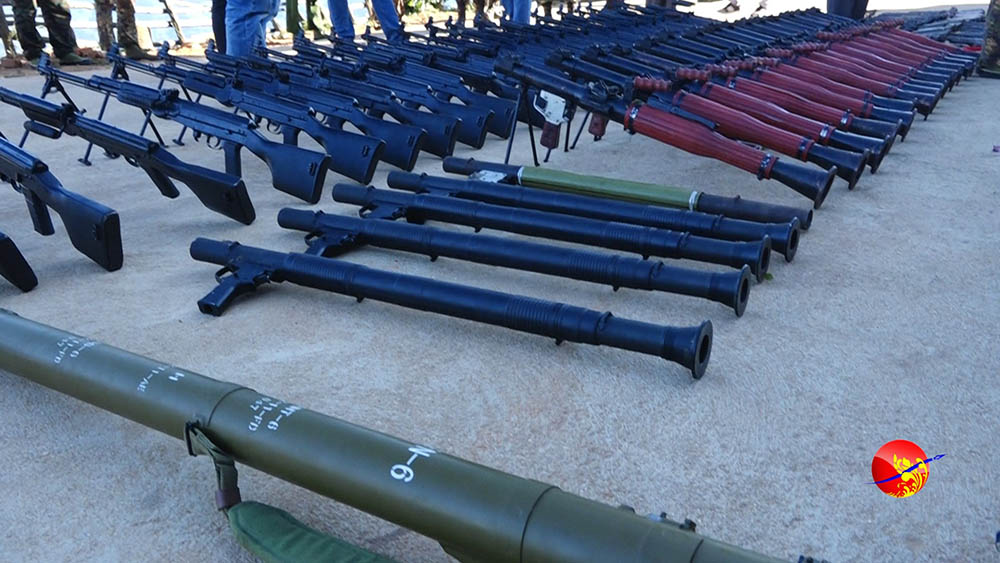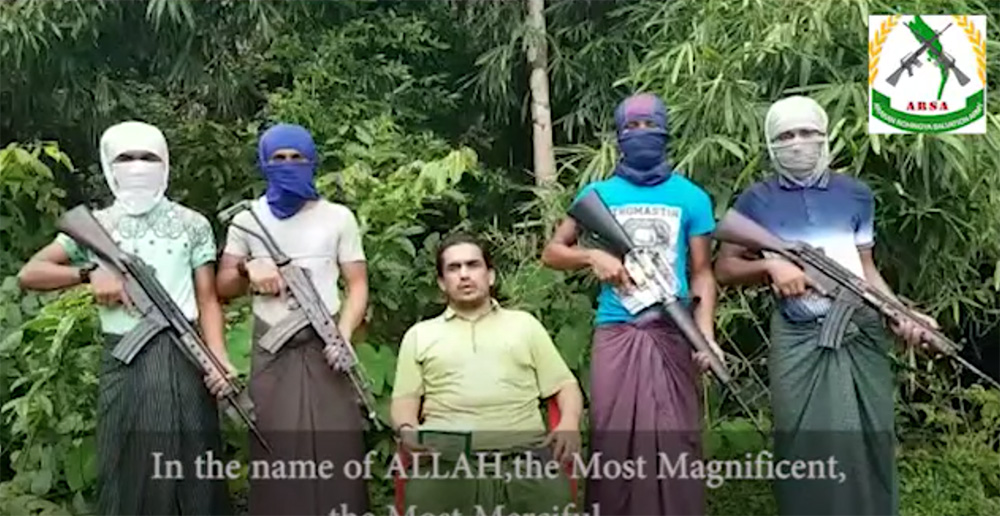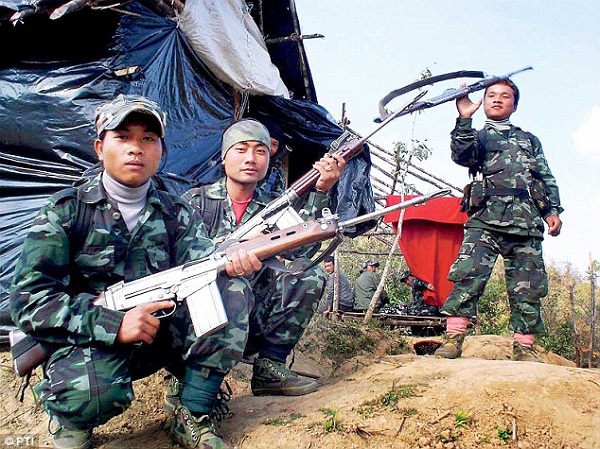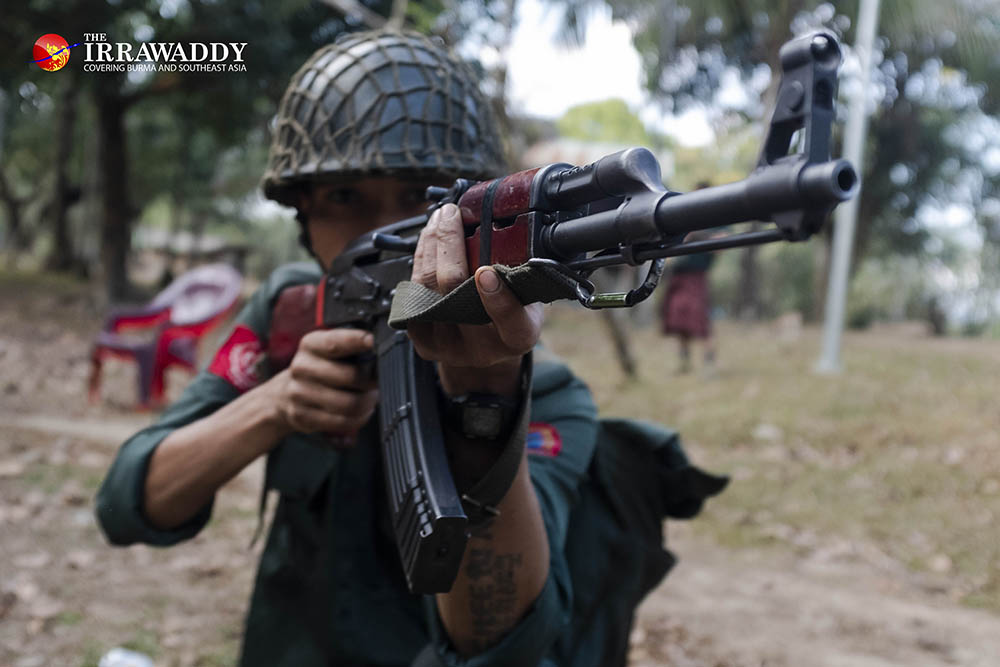As the daily fighting against ethnic Rakhine insurgents in northern Rakhine State grinds on, the generals in Naypyitaw have implicitly pointed the finger at a powerful neighbor, accusing it of providing support to certain insurgent groups in the country. Of course, they do not dare to name the country publicly.
Speaking to the media in Russia last week, Myanmar military commander-in-chief Senior General Min Aung Hlaing called for international cooperation in the fight against terrorism and claimed that terrorist groups exist because of the strong forces that support them. So who, exactly, are these strong forces?
Many believe Snr-Gen Min Aung Hlaing’s comment was targeted at China, which the Myanmar military (or Tatmadaw) suspects is continuing to provide arms to rebel groups on the Myanmar-China border and to the Arakan Army (AA), which is now operating in northern Rakhine State.
In the staged interview, Snr-Gen Min Aung Hlaing did not name the terrorist organizations, nor did the interviewer ask. But a military spokesperson told The Irrawaddy that the senior general was referring to the AA and the Arakan Rohingya Salvation Army (ARSA), both of which are based in northern Rakhine.

ARSA—which has an entirely separate agenda from the AA—has established links with several overseas radical Islamist armed groups and insurgents in neighboring Bangladesh, as well as in Pakistan and Afghanistan. The Rohingya movement has received funding and political support from countries and sympathizers in the Middle East and from some countries in the West.
According to military insiders and observers, the sustained heavy frontline fighting against the AA is taking a toll at military headquarters in Naypyitaw, with rational planning sometimes giving way to more emotional responses. The Rakhine rebels have no shortage of arms and ammunition, and have been trained in the use of sophisticated explosives. They engage in hit-and-run guerilla warfare, and their frequent attacks on military outposts are reminiscent of the tactics used by the now defunct Communist Party of Burma (CPB), which was known for its ability to launch offensives in large numbers.
It is important to note that in the past, the CPB also received political and military support from China.
While China has offered to play the role of peace broker in Myanmar’s ongoing ethnic conflicts, senior Tatmadaw leaders now say confidentially that China is not to be trusted, and in fact continues to support some ethnic insurgent groups in Myanmar, while at the same time meddling in the peace process.
In 2017, Chinese President Xi Jinping told State Counselor Daw Aung San Suu Kyi that China would continue to help Myanmar achieve peace, and called for all sides to maintain stability on the countries’ shared border. Since then, however, Rakhine State has become even less stable and armed conflict in Myanmar has only intensified.
In August 2019, the ethnic rebel alliance known as the Northern Alliance-Burma (NAB) staged one of the most audacious attacks seen in years, assaulting the garrison town of Pyin Oo Lwin, also known as Maymyo, near Mandalay, Myanmar’s second-largest city. The insurgent operations targeted a military academy and later attacked trade routes with China.

Unsurprisingly, three rebel groups—the Palaung Ta’ang National Liberation Army (TNLA), the ethnic Chinese Myanmar National Democratic Alliance Army (MNDAA) based in the Kokang region, and the AA—were behind the attacks. All three of these groups are known to be close to the Chinese, and their leaders often visit or stay in Yunnan province and other places in the Chinese border area.
In November 2019 and January 2020, the Myanmar military seized several caches of weapons and other military hardware in northern Shan State.
According to a military statement and photos, among the seized weapons were 39 M-22 assault rifles, 29 medium machine guns, 69 M-21 assault rifles, nine M-16 assault rifles, 16 RPG-7s, five RPG-2s, two 12-volt spotlights and one FN-6 shoulder-fired surface-to-air missile, plus 77 bags of TNLA uniforms, flags and military equipment.
The military spokesman said at the time that most of the seized weapons were Chinese made, and that rebel groups had illegally acquired them from China.
Then, in a meeting with Chinese Special Envoy for Asian Affairs Sun Guoxiang, Snr-Gen Min Aung Hlaing reportedly told the envoy that rebels based in the north were buying weapons from China.
Soon after the meeting, in an exclusive interview with Japan’s Yomiuri Shimbun newspaper, Snr-Gen Min Aung Hlaing mentioned that rebels in Myanmar received arms from China indirectly, but didn’t elaborate.
Military insiders also say the AA has modern technologies that allow its fighters to trigger landmines via mobile phones, walkie-talkies, Bluetooth and Wi-Fi. Indeed, the training and equipment needed to set up such explosives is likely to come from a neighboring country.
During Xi’s visit to Myanmar in January, both Daw Aung San Suu Kyi and Snr-Gen Min Aung Hlaing mentioned the need for stability on the border—sending a coded message to China that Myanmar doesn’t want to see it arming and supporting insurgents on the frontier.
In Russia last week, Snr-Gen Min Aung Hlaing held talks with Indian Defense Minister Rajnath Singh and discussed ways of promoting ties between their countries’ armed forces, as well as border security and counterinsurgency operations along the border. One of the more interesting regional developments to watch of late has been the cultivation of a closer friendship between Naypyitaw and New Delhi.

In May, the Myanmar government handed 22 ethnic Assam and Meitei rebels over to the Indian government. The rebels belonged to groups fighting New Delhi from bases along the border in Myanmar’s Sagaing Region.
Myanmar received its first submarine from India last year, a Russian-made Kilo-class diesel-electric attack submarine, and India continues to provide technical support for the vessel, according to a Myanmar military spokesman. Most importantly, New Delhi has also agreed to train Myanmar army officers and allow them to study at military academies in India. (In a decision with clear political implications, Myanmar opted not to buy submarines from China.)
To demonstrate their seriousness about denying Indian insurgents the ability to operate on Myanmar’s soil, last year the two countries’ security forces cooperated to clamp down on the groups, with Myanmar troops driving insurgents hailing from Nagaland and other states in northeastern India out of their main base in Taga, in northern Sagaing Region.
These insurgent groups, which are fighting for autonomy, have large networks in Myanmar, Thailand and India. They are involved in various forms of illicit trade, including arms smuggling, and some have established regular contact with radical Islamist insurgent groups.
Rooting out such groups is not an easy task, and it is expected that the Indian and Myanmar armed forces will have to coordinate even more closely if they are to effectively clamp down on these insurgents.
Meanwhile, inside Myanmar the resourceful Indian rebels continue to operate, opening bases and training camps and establishing contacts with insurgents and terrorist organizations overseas.
Interestingly, the AA Rakhine rebels have made efforts to disrupt the movement of materials along the Kaladan River for a joint infrastructure project with India, even kidnapping Indian project workers traveling in the area. One Indian man died while being detained by the AA.

The Kaladan Multimodal Transit Transport Project aims to open sea routes and a highway transport system linking the eastern Indian seaport of Kolkata with the country’s landlocked northeastern state of Mizoram through Myanmar’s Rakhine and Chin states.
At their meeting, Snr-Gen Min Aung Hlaing and the Indian defense minister discussed ways of cooperating on security to ensure the successful implementation of the Kaladan project across the Mizoram border. This means we can expect more offensives against the AA. New Delhi will support the Myanmar army in the form of intelligence and surveillance.
Importantly, this strengthening of relations with India comes against the backdrop of a recent violent confrontation between the two Asian giants in the Himalayan region of Ladakh—a new geopolitical flashpoint in South Asia.
Myanmar’s geostrategically important location in Southeast Asia, sitting between the two giants China and India (not to mention its natural resources), has long been a constant theme of comment among experts and scholars.
Today, that position feels more like a geopolitical curse for Myanmar, and the country will have to tread carefully as it balances its relations with its two powerful neighbors.
Needless to say, Snr-Gen Min Aung Hlaing’s recent remark about “strong forces” supporting terrorists inside Myanmar broadly reflects the sentiment among the top military leadership of the armed forces in Naypyitaw.
It also demonstrates that Myanmar is ready to balance Chinese influence and diversify its alliances in the region to include partners both old and new. Myanmar’s leaders are no longer in the pocket of the Chinese, as some media have suggested, and never will be.
You may also like these stories:
Remembering Kraisak Choonhavan—a Friend to Myanmar Laborers and Refugees in Thailand
Myanmar’s Ruling NLD Must Address Its Achilles’ Heel: Choosing the Wrong People
What Do We Want a Post-Pandemic Myanmar to Look Like?

















